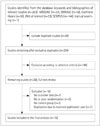1. Yeom J, Yoo R, Bae S, Kang Y, Kim GH, Na HR, et al. Recent updates of therapeutic intervention programs for caregivers of patient with dementia: proposal of hospital-based individual therapy. Dement Neurocognitive Disord. 2016; 15:29–36.

2. González-Salvador MT, Arango C, Lyketsos CG, Barba AC. The stress and psychological morbidity of the Alzheimer patient caregiver. Int J Geriatr Psychiatry. 1999; 14:701–710.

3. Pinquart M, Sörensen S. Helping caregivers of persons with dementia: which interventions work and how large are their effects? Int Psychogeriatr. 2006; 18:577–595.

4. Schulz R, Beach SR. Caregiving as a risk factor for mortality: the caregiver health effects study. JAMA. 1999; 282:2215–2219.
5. Cuijpers P. Depressive disorders in caregivers of dementia patients: a systematic review. Aging Ment Health. 2005; 9:325–330.

6. Thomas P, Chantoin-Merlet S, Hazif-Thomas C, Belmin J, Montagne B, Clément JP, et al. Complaints of informal caregivers providing home care for dementia patients: the Pixel study. Int J Geriatr Psychiatry. 2002; 17:1034–1047.

7. Butler AC, Chapman JE, Forman EM, Beck AT. The empirical status of cognitive-behavioral therapy: a review of meta-analyses. Clin Psychol Rev. 2006; 26:17–31.

8. EndNote X7.5. Philadelphia (PA): Thomson Reuters;2016.
9. Higgins JP, Thompson SG, Deeks JJ, Altman DG. Measuring inconsistency in meta-analyses. BMJ. 2003; 327:557–560.

10. Akkerman RL, Ostwald SK. Reducing anxiety in Alzheimer's disease family caregivers: the effectiveness of a nine-week cognitive-behavioral intervention. Am J Alzheimers Dis Other Demen. 2004; 19:117–123.

11. Arango-Lasprilla JC, Panyavin I, Merchán EJ, Perrin PB, Arroyo-Anlló EM, Snipes DJ, et al. Evaluation of a group cognitive-behavioral dementia caregiver intervention in Latin America. Am J Alzheimers Dis Other Demen. 2014; 29:548–555.

12. Au A, Li S, Lee K, Leung P, Pan PC, Thompson L, et al. The Coping with Caregiving Group Program for Chinese caregivers of patients with Alzheimer's disease in Hong Kong. Patient Educ Couns. 2010; 78:256–260.

13. Gallagher-Thompson D, Gray HL, Dupart T, Jimenez D, Thompson LW. Effectiveness of cognitive/behavioral small group intervention for reduction of depression and stress in non-hispanic white and hispanic/latino women dementia family caregivers: outcomes and mediators of change. J Ration Emot Cogn Behav Ther. 2008; 26:286–303.

14. Gallagher-Thompson D, Gray HL, Tang PC, Pu CY, Leung LY, Wang PC, et al. Impact of in-home behavioral management versus telephone support to reduce depressive symptoms and perceived stress in Chinese caregivers: results of a pilot study. Am J Geriatr Psychiatry. 2007; 15:425–434.

15. Gendron C, Poitras L, Dastoor D, Pérodeau G. Cognitive-behavioral group intervention for spousal caregivers: findings and clinical considerations. Clin Gerontol. 1996; 17:3–19.
16. Glueckauf RL, Jeffers SB, Sharma D, Massey AJ, Davis WS, Wesley LM, et al. Telephone-based cognitive-behavioral intervention for distressed rural dementia caregivers: initial findings. Clin Gerontol. 2007; 31:21–41.

17. Losada Baltar A, Izal Fernández de Trocóniz M, Montorio Cerrato I, Márquez González M, Pérez Rojo G. Differential efficacy of two psychoeducational interventions for dementia family caregivers. Rev Neurol. 2004; 38:701–708.
18. Cristancho-Lacroix V, Wrobel J, Cantegreil-Kallen I, Dub T, Rouquette A, Rigaud AS. A web-based psychoeducational program for informal caregivers of patients with Alzheimer's disease: a pilot randomized controlled trial. J Med Internet Res. 2015; 17:e117.

19. Losada A, Márquez-González M, Romero-Moreno R. Mechanisms of action of a psychological intervention for dementia caregivers: effects of behavioral activation and modification of dysfunctional thoughts. Int J Geriatr Psychiatry. 2011; 26:1119–1127.

20. Márquez-González M, Losada A, Izal M, Pérez-Rojo G, Montorio I. Modification of dysfunctional thoughts about caregiving in dementia family caregivers: description and outcomes of an intervention programme. Aging Ment Health. 2007; 11:616–625.

21. Marriott A, Donaldson C, Tarrier N, Burns A. Effectiveness of cognitive-behavioural family intervention in reducing the burden of care in carers of patients with Alzheimer's disease. Br J Psychiatry. 2000; 176:557–562.

22. Schulz R, O'Brien AT, Bookwala J, Fleissner K. Psychiatric and physical morbidity effects of dementia caregiving: prevalence, correlates, and causes. Gerontologist. 1995; 35:771–791.

23. Schulz R, Visintainer P, Williamson GM. Psychiatric and physical morbidity effects of caregiving. J Gerontol. 1990; 45:181–191.

24. Russo J, Vitaliano PP, Brewer DD, Katon W, Becker J. Psychiatric disorders in spouse caregivers of care recipients with Alzheimer's disease and matched controls: a diathesis-stress model of psychopathology. J Abnorm Psychol. 1995; 104:197–204.

25. Vitaliano PP, Zhang J, Scanlan JM. Is caregiving hazardous to one's physical health? A meta-analysis. Psychol Bull. 2003; 129:946–972.

26. Martire LM, Hall M. Dementia caregiving: recent research on negative health effects and the efficacy of caregiver interventions. CNS Spectr. 2002; 7:791–796.

27. Pinquart M, Sörensen S. Associations of stressors and uplifts of caregiving with caregiver burden and depressive mood: a meta-analysis. J Gerontol B Psychol Sci Soc Sci. 2003; 58:112–128.

28. Losada A, Márquez-González M, Romero-Moreno R, López J, Fernández-Fernández V, Nogales-González C. Attending to dementia caregivers diverse needs: contributions from cognitive-behavioral therapy and acceptance and commitment therapy. Clin y Salud. 2015; 26:41–48.
29. Radloff LS. The CES-D Scale: a self-report depression scale for research in the general population. Appl Psychol Meas. 1977; 1:385–401.
30. Hertzog C, Van Alstine J, Usala PD, Hultsch DF, Dixon R. Measurement properties of the Center for Epidemiological Studies Depression Scale (CES-D) in older populations. Psychol Assess. 1990; 2:64–72.

31. Gupta R, Yick A. Validation of CES-D scale for older Chinese immigrants. J Ment Health Aging. 2001; 7:257–272.









 PDF
PDF ePub
ePub Citation
Citation Print
Print


 XML Download
XML Download